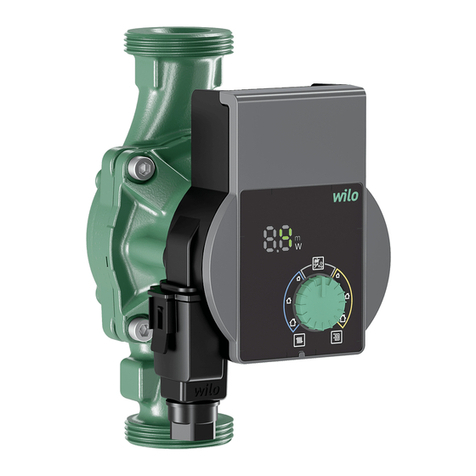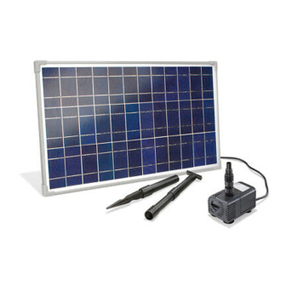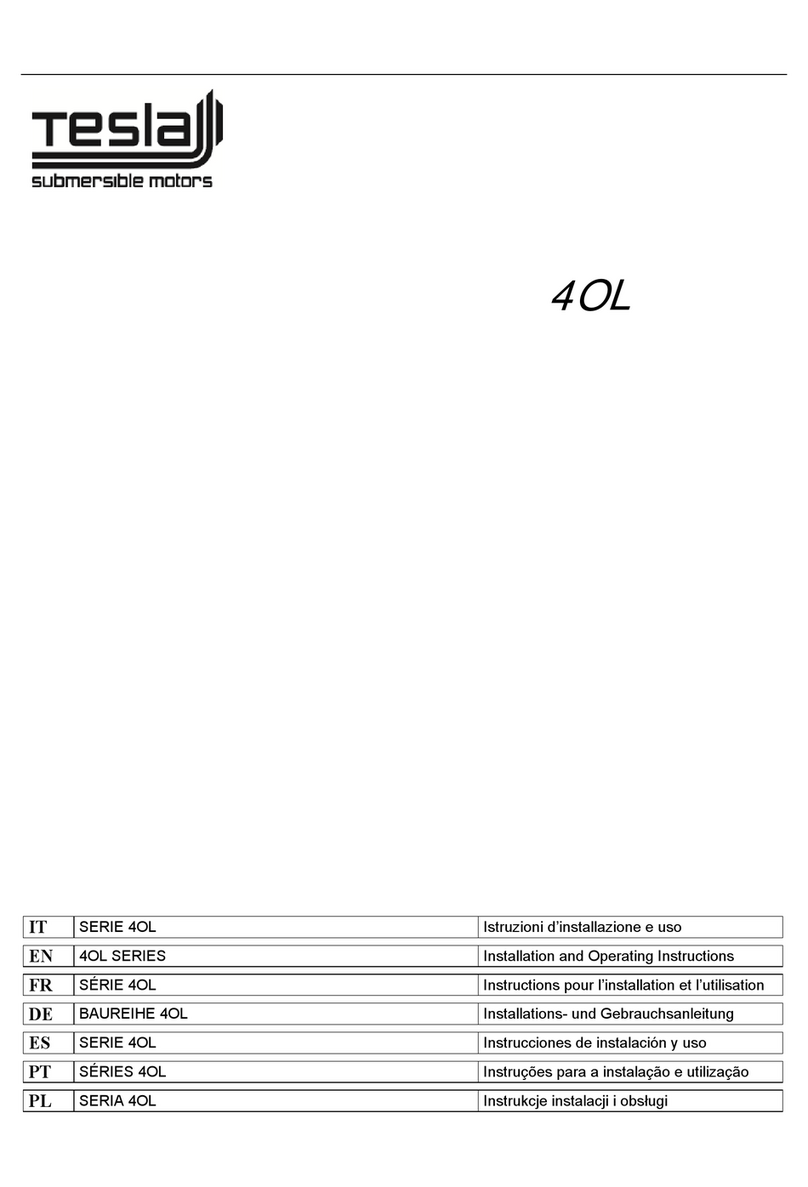EnviroGear E Series Owner's manual

envirogearpump.com
Where Innovation Flows
E Series
Seal-less Internal
Gear Pumps
IOM
Installation
Operation &
Maintenance

SECTION X
TABLE OF CONTENTS
SECTION 1 CAUTIONS—READ FIRST! ...................................................1
SECTION 2 PUMP DESIGNATION SYSTEM ..............................................3
SECTION 3 HOW IT WORKS – INTERNAL GEAR TECHNOLOGY .........................4
SECTION 4 TECHNICAL INFORMATION
Sizes Available ..................................................................5
Pump Selection Performance Criteria .............................................5
Temperature Ratings ............................................................6
Magnetic-Coupling Strengths ....................................................7
Relief Valve Performance .........................................................8
Internal Cooling Circuit ..........................................................9
Rotation and Port Orientation ...................................................10
SECTION 5 SUGGESTED INSTALLATION & OPERATION................................11
SECTION 6 PUMP ADJUSTMENTS AND MAINTENANCE ..............................17
SECTION 7 PUMP DISASSEMBLY & REPAIR PROCESSES .............................19
SECTION 8 EXPLODED VIEW & PARTS LISTING........................................35
SECTION 9 TROUBLESHOOTING.........................................................58
SECTION
10
WARRANTY ..................................................................61

ENV-11000-E-04 1ENVIROGEAR
SECTION 1
CAUTIONS–READ FIRST!
WARNING: In any positive-displacement pump system,
a reliable pressure-protection device must be used in the
discharge piping to avoid a dangerous pressure increase, which
could cause the pump or any component in the discharge piping
to burst and can lead to serious injury. A pump-mounted integral
relief valve is not intended to be used in this manner.
WARNING: This pump contains powerful permanent magnets
that can cause serious injury. Read the appropriate section of
this IOM before doing any service work.
WARNING: Magnetic field can disrupt medical implants such
as pacemakers. Implant wearers should remain a minimum of 0.3
m (1 ft) away from pump and 1 m (3 ft) away from disassembled
magnets.
WARNING: Magnets inside the pump can damage electronic
equipment or magnetic media.
WARNING: This pump is designed to rotate only in the direction
indicated. Do not run the pump in the opposite direction for long
periods because internal passageways that control axial thrust
will not work correctly, causing premature wear and reduced
pumping efficiency.
WARNING: The inner magnets on the back of the rotor
assembly are strongly attracted to the outer magnets in the
outer-drive assembly. During the separation process, there
will be a strong force of up to 136 kg (300 lbs) trying to pull
them back together, which can create a powerful pinch point.
WARNING: Failure to have each magnet segment in opposite
polarity with adjacent magnets will cause a significant reduction
of coupling torque.
WARNING: Maximum temperature limits are based upon
mechanical stress only. Certain chemicals will significantly
reduce maximum safe operating temperatures. Consult
Chemical Resistance Guide for chemical compatibility and
temperature limits.
WARNING: Prevent static sparking. If static sparking occurs,
fire or explosion could result. Pump, valves and containers
must be grounded to a proper grounding point when handling
flammable fluids and whenever discharge of static electricity is
a hazard.
WARNING: For applications requiring CE or ATEX, refer to the
E Series Safety Supplement for addition cautions and warnings.
CAUTION: Only personnel who are familiar with the operation
and repair of mechanical products should perform the necessary
maintenance. You must familiarize yourself with the entire
contents of this manual prior to operating and/or performing any
maintenance.
CAUTION: When selecting a E Series pump for an application,
you must first ensure that the pump components are compatible
with the process media.
CAUTION: Do not operate this pump in excess of its rated
capacity, pressure, speed and temperature.
CAUTION: Before any maintenance and repair is attempted,
disconnect the drive.
CAUTION: Before any maintenance or repair is attempted, bleed
all pressure from the pump through the suction or discharge lines.
CAUTION: Do not remove any pressure-containing components
during pump operation.
CAUTION: All E Series pumps contain residual hydraulic oil
from the factory production test. Hypar-FG 15 food-grade oil is
the standard production test fluid, but any certified performance
testing may be done on a non-food grade oil, such as Unilube 32
(ISO 32) or Unilube 100 (ISO 100). Determine if this is compatible
with the fluid you are pumping. If the fluid is incompatible, then
the pump must be fully flushed prior to use.
CAUTION: When pumping fluids at elevated temperatures,
care should be taken to gradually increase temperature. Rapid
temperature increase can damage internal components.
CAUTION: Ensure that the pump has cooled to a safe
temperature before any maintenance or repair is attemped.
CAUTION: When pumping fluids at elevated temperatures
the piping may expand, resulting in excessive stress on the
pump. This can cause pump failure. Care must be taken when
considering pipe design to avoid damage from thermal expansion.
CAUTION: All inlet and discharge plumbing should be clean and
free from foreign material prior to startup of pump.
CAUTION: When connecting to an electric motor, follow all
safety recommendations provided by the motor manufacturer.
CAUTION: Never remove safety guards from shafts, couplings,
V-belts or pulleys during operation. Doing so could result in injury.
CAUTION: Do not wear loose or dangling clothing or jewelry
near the equipment. These items could become caught in the
equipment and cause injury.
CAUTION: Before any maintenance or repair is attemped,
ensure that the pump has been thoroughly flushed of any
hazardous fluids. Review the Material Safety Data Sheet (MSDS)
applicable to the fluid for proper handling.
• Crane, hoist or other suitable lifting device capable of
lifting at least 182 kg (400 lbs)
• Sturdy workbench that is positioned beneath the
lifting device and is firmly anchored to the floor, or if
unanchored, the workbench must weigh at least 182 kg
(400 lbs), and be strong enough to resist a lifting force of
up to 182 kg (400 lbs)
• Pump Disassembly Tool F-00096 or F-00097
To safely separate the rotor assembly from the outer-
drive assembly, follow the instructions below and use the
following equipment:

ENVIROGEAR 2ENV-11000-E-04
SECTION X
Always read the most current version of this manual before performing any work on or around this pump.The
most current version of the manual is freely available on the web at www.envirogearpump.com.
EnviroGear pumps are specifically configured for your unique application conditions.Those application
conditions and the details of the pump configuration were documented during the ordering process. Keep
that information available in a safe place, as it may be needed when troubleshooting pump problems or when
ordering spare parts or repairs.
EnviroGear pumps are covered by one or more of the following patents: U.S. Patent Nos. 7549205, 7137793,
7183683; 8,608,465B2 Australian Patent No. AU2005233534B2; Korean Patent No. 10-2006-7023162; Mexican
Patent No. PA/a/2006/011436; Russian Patent No. 2006138540/06(041952); China Patent No. ZL 201280031563.6;
and other patents pending.

ENV-11000-E-04 3ENVIROGEAR
SECTION 2
PUMP DESIGNATION SYSTEM
MODELS:
E1-2 = 2 in3/rev
E1-4 = 4 in3/rev
E1-24 = 24 in3/rev
E1-32 = 32 in3/rev
E1-55 = 55 in3/rev
E1-69 = 69 in3/rev
E1-82 = 82 in3/rev
E1-133 = 133 in3/rev
E1-222 = 222 in3/rev
MATERIALS:
C = CARBON STEEL
D = DUCTILE IRON
S = STAINLESS STEEL
W = CAST IRON
CLEARANCES (E12/4/24/32/55/69/82/133/222):
A = A [<100 cSt, (<149C) <300F]
B = B [100-5000 cSt, (<149C) <300F]
C = C [>5000 cSt, (<149C) <300F]
D = D [<100 cSt, (>149C) >300F]
E = E [100-5000 cSt, (>149C) >300F]
F = F [>5000 cSt,(>149C) >300F ]
PORTS:
1.5A = 1.5" ANSI
1.5B = 1.5" BSPT
1.5D = DN40 (1.5") PN16
1.5N = 1.5" NPT
2A = 2" ANSI
2S = 2" ANSI (180°)
2B = 2" BSPT
2D = DN50 (2") PN16
2N = 2" NPT
3A = 3" ANSI
3S = 3" ANSI (180°)
3D = DN80 (3") PN16
4A = 4" ANSI
6S = 6" ANSI
ORIENTATION:
RT = Right suction, Top discharge
LT = Left suction, Top discharge
TR = Top suction, Right discharge
TL = Top suction, Left discharge
RL = Right suction, Left discharge
LR = Left suction, Right discharge
LB = Left suction, Bottom discharge
BR = Bottom suction, Right discharge
BL = Bottom suction, Left discharge
RB = Right suction, Bottom discharge
O-RINGS:
V = Viton®, DuPont Type "A"
T = FEP-encapsulated Viton®
S = PFA-encapsulated silicone
K6 = Kalrez®6375
K7 = Kalrez®7075
BUSHINGS:
B = Bronze bushings, Standard Spindle
C = Carbon-graphite bushings, Standard
Spindle
H = Carbon-graphite bushings, Hardened
17-4PH Spindle
R = Resin Impregnated Carbon-graphite
bushings, Standard Spindle
T = Tungsten carbide bushings, Hardened
Spindle
I =
Hardened cast iron bushings, Hardened
Spindle
MAGNETS:
6L = M6L standard-strength / standard-temp.
[(<135C) <275 F]
6M = M6M standard-strength / medium-temp.
[(<190C) <375F]
6H = M6H standard-strength / high-temp.
[(<260C) <500F]
7L = M7L high-strength / standard-temp.
[(<135C) <275 F]
7M = M7M high-strength / medium-temp.
[(<190C) <375F]
7H = M7H high-strength / high-temp.
[(<260C <500F)]
RELIEF VALVE (E1-2/4/24/32/55/69/82)
N = NO RELIEF VALVE
05 = Cracks at 50 +/-10 psi delta P
07 = Cracks at 75 +/-10 psi delta P
10 = Cracks at 100 +/-10 psi delta P
12 = Cracks at 125 +/-10 psi delta P
15 = Cracks at 150 +/-10 psi delta P
17 = Cracks at 175 +/-10 psi delta P
20 = Cracks at 200 +/-10 psi delta P
RELIEF VALVE (E1-133/222):
CAST IRON/CARBON STEEL
N = NO RELIEF VALVE
05 = Full bypass at 20 to 50 psi
08 = Full bypass at 51 to 80 psi
13 = Full bypass at 81 to 130 psi
20 = Full bypass at 131 to 200 psi
RELIEF VALVE (E1-133/222):
STAINLESS STEEL
N = NO RELIEF VALVE
05 = Full bypass at 20 to 50 psi
08 = Full bypass at 51 to 80 psi
15 = Full bypass at 81 to 150 psi
SHAFT:
S = Standard shaft (no optional shaft selected)
V = Smaller shaft (matches mtg dims of Viking L/LQ/LL)
14 = Close Coupled 140TC NEMA
18 = Close Coupled 180TC NEMA
21 = Close Coupled 210TC NEMA
25 = Close Coupled 250TC NEMA
SPECIALTY CODE:
Contact Factory
EXAMPLE:
E1-69SA/3ART/TC6L/10/S/310
E1- MODEL MATERIAL CLEARANCE /PORTS ORIENTATION /O-RINGS BUSHINGS MAGNETS /RELIEF
VALVE /SHAFT /SPECIALTY
CODE
2 C A 1.5A RT V B 6L N S XXX
4 D B 1.5B LT T C 6M 05 V
24 S C 1.5D TR S H 6H 07 14
32 W D 1.5N TL K6 R 7L 08 18
55 E 2A RL K7 T 7M 10 21
69 F 2S LR I 7H 12 25
82 2B LB 13
133 2D BR 15
222 2N BL 17
3S RB 20
3S
3D
4A
6S

ENVIROGEAR 4ENV-11000-E-04
SECTION 3
HOW IT WORKS—INTERNAL GEAR TECHNOLOGY
1
3 4
2
INLET
OUTLET
INLET
OUTLET
INLET
OUTLET
INLET
OUTLET
The shaded area indicates the liquid as it
is drawn into the liquid inlet port of the
pump. As the rotor turns, atmospheric
pressure forces the liquid between the
rotor teeth and idler teeth. The two
arrows indicate the rotational direction
of the pump.
As the rotor continues to turn, the liquid
is forced through the crescent-shaped
area of the wetted path. The crescent-
shaped area divides the liquid and acts as
a barrier between the inlet and discharge
ports.
As the rotor continues to turn, the liquid
is forced past the crescent-shaped area
and moves toward the discharge port.
As the rotor completes one complete
rotation, the rotor and idler teeth
interlock, forcing the liquid through the
discharge of the pump. The pump may
take several rotations to completely
prime depending on the conditions of the
application.
The E SERIES GEAR PUMP is a rotating positive displacement pump. These drawings show the flow pattern through
the pump upon its initial rotation. It is assumed that the pump has no fluid in it prior to its initial rotation.

ENV-11000-E-04 5ENVIROGEAR
SECTION 4
TECHNICAL INFORMATION
SIZES AVAILABLE
Model
Cast Iron/ Ductile Iron
Port Sizes Carbon Steel Port Sizes1Stainless Steel Port Sizes1Pump Weight
E1-2 N/A 1-1/2" NPT/ANSI/BSPT 1-1/2" NPT/ANSI/BSPT 24 kg (53 lb)
E1-4 N/A 1-1/2" NPT/ANSI/BSPT 1-1/2" NPT/ANSI/BSPT 24 kg (53 lb)
E1-24 2" NPT/ANSI1/BSPT 2" NPT/ANSI/BSPT - 3" ANSI 2" NPT/ANSI/BSPT - 3" ANSI 69 kg (152 lb)
E1-32 2" NPT/ANSI1/BSPT 2" NPT/ANSI/BSPT - 3" ANSI 2" NPT/ANSI/BSPT - 3" ANSI 69 kg (152 lb)
E1-55 3" ANSI1- 4" ANSI13" ANSI - 4" ANSI 3" ANSI - 4" ANSI 139 kg (307 lb)
E1-69 3" ANSI1- 4" ANSI13" ANSI - 4" ANSI 3" ANSI - 4" ANSI 139 kg (307 lb)
E1-82 3" ANSI1- 4" ANSI13" ANSI - 4" ANSI 3" ANSI - 4" ANSI 139 kg (307 lb)
E1-133 4" ANSI24" ANSI 4" ANSI 250 kg (552 lb)
E1-222 6" ANSI26" ANSI 6" ANSI 270 kg (596 lb)
1Flanged connections meet Class 150# ANSI
2Flanged connections meet Class 125# ANSI
PUMP SELECTION PERFORMANCE CRITERIA
Model
Nominal Pump Rating
1,2Max.
Discharge
Pressure
Max.
Temperature Nominal Pump Rating
1,2Max.
Discharge
Pressure
Max.
Temperature
CAST IRON / DUCTILE IRON / CARBON STEEL STAINLESS STEEL
rpm m3/h (gpm) bar (psig) Celsius (Fahrenheit) rpm m3/h (gpm) bar (psig) Celsius (Fahrenheit)
E1-2 1,750 3.4 (15) 13.8 (200) 260° (500°) 1,150 2.3 (10) 10.3 (150) 260° (500°)
E1-4 1,750 6.8 (30) 13.8 (200) 260° (500°) 1,150 4.5 (20) 10.3 (150) 260° (500°)
E1-24 780 17.0 (75) 13.8 (200) 260° (500°) 640 12.5 (55) 10.3 (150) 260° (500°)
E1-32 780 22.7 (100) 13.8 (200) 260° (500°) 640 18.2 (80) 10.3 (150) 260° (500°)
E1-55 640 30.7 (135) 13.8 (200) 260° (500°) 520 25.0 (110) 10.3 (150) 260° (500°)
E1-69 640 38.6 (170) 13.8 (200) 260° (500°) 520 31.8 (140) 10.3 (150) 260° (500°)
E1-82 640 45.4 (200) 13.8 (200) 260° (500°) 520 36.3 (160) 10.3 (150) 260° (500°)
E1-133 520 68.1 (300) 13.8 (200) 260° (500°) 520 68.1 (300) 10.3 (150) 260° (500°)
E1-222 520 113.6 (500) 13.8 (200) 260° (500°) 520 113.6 (500) 10.3 (150) 260° (500°)
1Maximum pressure listed reflects maximum differential pressure and maximum allowable working pressure
2Consult factory for differential pressures below 1.4 bar (20 psig)

ENVIROGEAR 6ENV-11000-E-04
SECTION 4
TECHNICAL INFORMATION
TEMPERATURE RATINGS

ENV-11000-E-04 7ENVIROGEAR
SECTION X
TECHNICAL INFORMATION
MAGNETIC-COUPLING STRENGTHS

ENVIROGEAR 8ENV-11000-E-04
RELIEF VALVE PERFORMANCE
Optional integral relief valves provide pump protection
from over-pressure conditions. While not intended for
continuous use, internal relief valves protect the pump
from closed discharge valves or other intermittent
over-pressurization of the system.
Depending on the size of the pump, you will get one
of two relief valve designs, a non-externally adjustable
or an externally adjustable relief valve.The design
of the E1-2 thru E1-82 are spring-loaded and contain
only three parts.This design addresses the problem of
over-pressurization by “cracking” (where the poppet
lifts off the seat) at the nominal pressure-relief setting,
allowing pumped fluid to recirculate internally from the
discharge side back to the suction side.
In order to maintain the integrity of the relief valve
setting, the E1-2 thru E1-82 relief valves are not
adjusted by means of an external jack screw. Rather,
seven relief valve settings are fixed at the factory
and adjusted by changing the poppet and spring
combinations. See the pump designation system
section for details on available E1-2 thru E1-82 relief
valve settings.
RELIEF VALVE PERFORMANCE
The design of E1-133 and E1-222 is spring-loaded and
externally adjustable. It addresses the problem of over
pressurization by initially cracking, and eventually
full-bypassing at the nominal pressure-relief setting,
allowing pump fluid to recirculate internally from the
discharge side back to the suction side.
To properly size the integral relief valve, it is important
to understand the difference between crack pressure
and full bypass pressure.
Crack pressure is the pressure at which the poppet just
begins to lift off the seat.This pressure is not affected
by variations in fluid viscosity or pump speed.The
pump will provide full flow rate at all pressures below
the cracking pressure. E1-2 through E-82 pressure relief
valves are sized based on cracking pressure.
Full bypass pressure is the pressure that occurs when
100% of the pump’s flow rate is bypassing internally
through the valve and no flow is exiting the pump. E1-
133 and E-222 pressure relief valves are sized based a
full bypass pressure.
Relief Valve – E1-2 thru E1-82 Models
Relief Valve – E1-133 and E1-222 Models
SECTION X
TECHNICAL INFORMATION
O-ring
spring
poppet
valve body
head
SUCTION
SIDE
PRESSURE
SIDE

ENV-11000-E-04 9ENVIROGEAR
SECTION X
TECHNICAL INFORMATION
INTERNAL COOLING CIRCUIT
This pump has an internal cooling circuit that
circulates some of the pumped fluid through the
magnet chamber.The circuit starts at the discharge
port and ends at the suction port.This circuit has three
functions:
• Cool the inner magnets
• Keep fluid in the magnet area from becoming
stagnant
• Lubricate and cool the rotor and idler bushings
NOTE: Consult factory at low differential pressures to
ensure proper cooling-path circulation.
There are special plugs in the casing and head that
must be in the correct position to complete the circuit:
1. The casing needs to be vented on the
DISCHARGE side. In some cases, this is
done with an orifice plug that has a hole in
it, positioned in the casing hole behind the
DISCHARGE port. In other cases, this is done by
leaving the casing hole behind the DISCHARGE
port open.
2. The casing block-off plug is solid (no hole). It
belongs in the casing hole behind the SUCTION
port.
3. The head block-off plug is solid (no hole). It is
only used in pumps that have no relief valve, and
it belongs in the head hole on the DISCHARGE
side.
Internal Cooling Circuit
This pump has an internal cooling circuit that circulates some of the pumped fluid through the
magnet chamber. The circuit starts at the discharge port and ends at the suction port. This circuit
h
Note: Consult factory at low differential pressures to ensure proper cooling path circulation.
as three functions:
1. cool the inner magnets,
2. keep fluid in the magnet area from becoming stagnant,
3. lubricate and cool the rotor and idler bushings.
There are special plugs in the casing and head that must be in the correct position to
complete the circuit:
1. The casing needs to be vented on the DISCHARGE side. In some cases,
this is done with an orifice plug that has a hole in it, positioned in the casing hole
behind the DISCHARGE port. In other cases, this is done by leaving the casing hole
behind the DISCHARGE port open.
2. The casing block-off plug is solid (no hole). It belongs in the casing hole behind the
SUCTION port.
3. The head block-off plug is solid (no hole). It is only used in pumps that have no relief
valve, and it belongs in the head hole on the DISCHARGE side.
Casing orifice
plug (with hole)
SUCTION
SUCTION
DISCHARGE
DISCHARGE
Casing block-off
plug (no hole)
Head block-off
plug (no hole)
This hole
left open
Figure 2.12 – special cooling circuit plugs in correct positions
Special Cooling Circuit Plugs in Correct Positions

ENVIROGEAR 10 ENV-11000-E-04
SECTION X
TECHNICAL INFORMATION
ROTATION AND PORT ORIENTATION
The pump is configured in one of the ten (10) possible
orientations shown inthe table below and it has labels
on it that indicates direction of rotation, suction port
and discharge port.

ENV-11000-E-04 11 ENVIROGEAR
E Series gear pumps are designed to meet the
performance requirements of even the most demanding
pumping applications. They have been designed
and manufactured to the highest standards and are
available in a number of different sizes to meet your
pumping needs. Refer to the performance section of
this manual for an in-depth analysis of the performance
characteristics of your pump.
INSTALLATION
Months of careful planning, study and selection efforts
can result in unsatisfactory pump performance if
installation details are left to chance.
Premature failure and long-term dissatisfaction can be
avoided if reasonable care is exercised throughout the
installation process.
LOCATION
Noise, safety and other logistical factors usually
dictate where equipment will be situated on the
production floor. Multiple installations with conflicting
requirements can result in congestion of utility areas,
leaving few choices for additional pumps.
Within the framework of these and other existing
conditions, every pump should be located in such a
way that key factors are balanced against each other to
maximum advantage.
ACCESS
The location of the pumping unit should be accessible.
If it’s easy to reach the pump for maintenance
personnel will have an easier time carrying out routine
inspections and adjustments. Should major repairs
become necessary, ease of access can play a key role
in speeding the repair process and reducing total
downtime.
FOUNDATION
BASEPLATES AND ANCHORS:
The preferred mounting for a baseplate is on a concrete
pad with grouting. No matter how robust the design,
there is always some flexibility in the baseplate itself.
If there is insufficient support under the baseplate, it
can distort causing alignment difficulties and normal
vibrations can be amplified to unacceptable levels
through resonance in the pump support and/or piping.
A properly grouted baseplate will resist distortion and
will provide sufficient mass to dampen any vibration.
NOTE: When pumps and motors are assembled on a
baseplate at the factory, a preliminary alignment is done
to ensure that the pump and motor can be aligned at its
installation.This alignment is not to be considered as a
final alignment. The factory alignment can, and does,
change during shipment and when the pumping unit is
installed. Actually, several alignments are necessary as
will be described later.
Anchor (foundation) bolts are used to hold the
baseplate to its support structure, whatever that may
be. In the preferred case of mounting the pump unit
on a concrete pad, the anchor bolts are set into the pad
as indicated in the following illustration. When pouring
the pad, it’s helpful to have a wooden template attached
to the foundation form to position the anchor bolts at
their locations as indicated on the pump unit assembly
drawing.
Anchor bolts are usually sized smaller than the
anchor bolt hole size in the base. Calculate bolt
length as indicated in the Figure A on the left.
The ID of the sleeve should be two bolt sizes
larger than the anchor bolt.
Allow approx. 19 mm - 38 mm (3/4" - 1-1/2")
space between the bottom edge of the
baseplate and the foundation for grouting.
A “Sleeve” type anchor bolt is shown here.
Alternatively, a “hook” or “J” type anchor bolt
may be used.
Pack the space between the anchor bolt and
sleeve to prevent concrete and/or grout from
entering this area.
–
SECTION 5
SUGGESTED INSTALLATION & OPERATION
TYPICAL ANCHOR BOLT (SLEEVETYPE)

ENVIROGEAR 12 ENV-11000-E-04
SECTION 4
SUGGESTED INSTALLATION & OPERATION
BASE INSTALLATION AND GROUTING:
NOTE: Before the baseplate is installed, it is advisable to
thoroughly clean the underside to enable the grouting
to adhere to it. Do not use oil-based cleaners since
grout will not bond to it.
Once the concrete pad has cured, the baseplate can be
carefully lowered over the anchor bolts.
Place shims or tapered wedges under the baseplate
at each of the anchor bolt positions to provide about
19 mm - 38 mm (0.75" - 1.50") clearance between the
base and the foundation. Adjust shims/wedges to level
the baseplate. Since there may be some flexibility in
the baseplate, we must perform an initial alignment
prior to grouting to ensure that a final alignment can
be achieved. See section covering Alignment of Pump/
Driver Shafts. Potential problems here include bowing
and/or twisting of the baseplate. If gross misalignment
is observed, shims/wedges may have to be added
under the mid-point of the base or the shims/wedges
at the corners may have to be adjusted to eliminate
any twist. If the driver feet are bolt-bound for horizontal
alignment, it may be necessary to loosen the pump
hold-down bolts and shift the pump and driver to
attain horizontal alignment. When alignment has been
achieved, lightly tighten the anchor bolts. The anchor
bolts should not be fully tightened until the grout has
set.
Grouting furnishes support for the pump unit baseplate
providing rigidity, helping to dampen any vibration and
serves to distribute the weight of the pump unit over the
foundation. To be effective, grouting must completely
fill all voids under the baseplate. For proper adhesion
or bonding, all areas of the baseplate that will be in
contact with the grout should be thoroughly cleaned.
See note above. The grout must be non-shrinking.
Follow the directions of the grout manufacturer for
mixing. Proceed with grouting as follows:
NOTE: If the size of the equipment or the layout of
the installation requires it, grouting can be done in
two steps as long as the first step is allowed to cure
completely before the second step is applied
1. Build a sturdy form on the foundation around the
baseplate to contain the grout.
2. Soak the top of the concrete foundation pad
thoroughly. Remove surface water before pouring.
3. Pour the grout through the hole(s) in the top and/or
through the open ends of the channel steel baseplate,
eliminating air bubbles by tapping, using a vibrator
or pumping the grout into place. If necessary, drill
vent holes into the top of the base to evacuate air.
4. Allow grout to set completely, usually a minimum of
48 hours.
5. Tighten foundation anchor bolts.
6. Recheck alignment to ensure that there have been
no changes.
7. After the grout has dried thoroughly, apply an oil
base paint to shield the grout from air and moisture.
PIPING
Final determination of the pump site should not be
made until the piping challenges of each possible
location have been evaluated. The impact of current
and future installations should be considered ahead of
time to make sure that inadvertent restrictions are not
created for any remaining sites.
The best choice possible will be a site involving the
shortest and straightest hookup of suction and discharge
piping. Unnecessary elbows, bends and fittings should
be avoided. Pipe sizes should be selected to keep
friction losses within practical limits.
All piping should be supported independently of the
pump. In addition, the piping should be aligned to
avoid placing stress on the pump fittings. To eliminate
possible closing of the line when performing pump
maintenance, a gate valve should be installed at the
suction line.
E Series gear pumps are positive displacement pumps;
as such, care must be used in protecting piping and
components used in your system. Pumps equipped
with an internal relief valve are designed to protect the
pump only. A system relief valve should be installed
along with the pump's internal relief valve.
When placing the pump, choose a location as close to
the product source as possible. Care should be taken
in your supply line to avoid cavitation due to viscosity
and suction lift. NOTE: Some liquids may become
thicker with temperature changes. Please refer to your
supplier of product being pumped for information
on viscosity changes due to temperature. Avoid air
pockets on suction side of pump when designing
piping layout. This will also reduce the possibility of
cavitation. The weight of the piping should not be
supported or absorbed by the pump. Suction and
discharge piping should be supported by pipe hangers
or another suitable means.

ENV-11000-E-04 13 ENVIROGEAR
E SERIES GEAR PUMPS ARE NOT SUITED FOR
PUMPING DIRTY, SOLID-LADEN LIQUIDS. A strainer
should be used on the suction side of the pump. The
strainer should consist of an adequate size mesh screen
as to not cause excessive friction loss. It is suggested
that a maintenance program is created to assure that
the inlet strainer remains free of obstructions and
blockage.
ALIGNMENT OF PUMP/DRIVER SHAFTS
WARNING!
NOTE: Driver power must be locked out before
beginning any alignment procedure. Failure to lockout
driver power may result in serious physical injury.
NOTE: Proper alignment is the responsibility of the
installer and user of the equipment.
NOTE: Check alignment if process temperature changes,
piping changes and/or pump service is performed.
Pump and driver shafts need to be aligned for
both parallel and angular alignment. If there is a
misalignment of the shafts, it will place a mechanical
load on the pump and driver shaft/bearing assemblies
as well as the coupling. This will result in vibration,
noise and premature failures.
Furthermore, due to the magnetic coupling design of
the E Series pump, misalignment can cause deflection
of the outer ring into the stationary magnet housing
and containment canister.This can cause bearing failure
which, if left undiagnosed, could lead to the outer ring
contacting and potentially breaching the containment
canister.
NOTE: There are design provisions that cause the outer
ring to contact the magnet housing or skid ring prior to
contacting the canister, but this is meant for short term
bearing failure containment, not long-term prevention
of outer ring to canister contact.
To bring shafts into alignment, we first need to
determine the amount and direction of both parallel
and angular misalignments. We can then shim and
reposition to correct.
It’s preferable to shim ONLY under the driver feet since
good contact between the pump foot and the base is
necessary to resist any pump flange loading that might
be imposed by the suction and/or discharge piping.
There are three methods commonly used to determine
misalignment:
1. Straight edge and calipers or inside micrometer
(least accurate)
2. Dial indicator (reasonably accurate)
3. Laser alignment equipment; see manufacturer’s
instructions for use
Since any misalignment will impose loads on the pump
and driver shafts, the objective is to minimize any
misalignment in order to protect the pump and driver
and minimize any tendency for vibration. Suggested
misalignment limits are:
For optimum performance and Mean Time Between
Pump Maintenance (MTBPM), use alignment limits half
of those shown above.
SECTION 4
SUGGESTED INSTALLATION & OPERATION
MISALIGNMENT LIMITS
PUMP FRAME GROUP MAX. PARALLEL MAX. ANGULAR
2/4, 24/32, 55/69, 82 0.005" 0.005"
133/222 0.010" 0.010"
PARALLEL MISALIGNMENT
ANGULAR MISALIGNMENT

ENVIROGEAR 14 ENV-11000-E-04
SECTION 4
SUGGESTED INSTALLATION & OPERATION
NOTE: In any case, disregard the coupling
manufacturer’s published misalignment limits, as these
will impose unacceptable loads on the pump and motor
shafts and bearings.
Alignment must be done at several different times:
1. Prior to grouting baseplate during installation
2. After grouting baseplate and tightening anchor bolts
3. After attaching suction and discharge piping prior to
initial operation
4. Hot alignment after equipment temperatures have
stabilized
5.
After pump maintenance bearing housing is removed
Since the E Series pump is foot-mounted, its shaft
centerline will rise when handling pumpage at elevated
temperatures. Similarly, the motor shaft centerline will
rise as it reaches its operating temperature. Therefore,
we will often purposely misalign shafts vertically
during cold alignment to allow for thermal growth,
thus bringing the shafts into alignment at operating
temperature. This is shown in the “COLD SETTING OF
PARALLEL VERTICAL ALIGNMENT “ table.
The most simple alignment check is with a straight
edge and calipers or inside micrometer. This method is
the least accurate, but it will serve if a dial indicator or
laser is not available.
ALIGNMENT WITH STRAIGHT EDGE AND MICROMETER:
With coupling hubs stationary, use inside micrometer
or calipers to measure the gap between the coupling
hubs at 90° intervals. Adjust and/or shim equipment
until the gap difference at all points around the hub(s)
is less than the value shown in the “MISALIGNMENT
LIMITS” table.
With coupling hubs stationary, lay straight edge flat
against rim of coupling hub to determine vertical
and horizontal alignment offsets. Adjust and/or shim
equipment until the straight edge lies flat against
both hub rims, vertical and horizontal.
DIAL INDICATOR METHOD
The dial indicator method is preferred for checking
alignment.
1. Scribe or mark index lines on both coupling hubs
to indicate where the dial indicator point rests.
2. Set dial indicator to zero.
3. Slowly turn BOTH coupling hubs so that the index
lines match or the indicator point is always on the
mark.
4. Observe dial reading to determine required
adjustments.
5. Acceptable parallel and angular alignment occurs
when the total indicator reading (TIR) for a
complete turn does not exceed the values shown
in the “MISALIGNMENT LIMITS” table.
LASER ALIGNMENT METHOD:
The laser alignment method is preferred for checking
alignment.
Laser alignment is usually the most accurate method.
Follow the laser alignment equipment manufacturer’s
instructions for this method.
ANGULAR ALIGNMENT
DIAL INDICATOR SETUP
PARALLEL MISALIGNMENT

ENV-11000-E-04 15 ENVIROGEAR
As previously mentioned, pump and motor shafts
need to be in alignment while they are at their
intended operating temperature. When the shafts
are aligned “cold” (at ambient temperature), we will
intentionally position the motor shaft up or down
in vertical parallel alignment to allow for thermal
growth. Then, when the alignment is checked “hot”
(at stable operating temperature), the shafts should
be confirmed to be in alignment. Use the values in the
following table as starting point for cold alignment
settings. The actual cold alignment setting will be
determined after the hot alignment is performed.
PRESSURE RELIEF VALVES:
• E Series pumps are positive displacement pumps,
which means the system must have provisions for
pressure relief protection, such as a relief valve
mounted directly on the pump or in-line with the
system. Alternatively, the system can be installed
with a torque-limiting device or a rupture disk.
• If the system requires the pump to operate in both
directions, pressure relief protection is required on
both sides of pump.
• When using an integral relief valve, the adjusting
screw cap must always point towards the suction
side of pump. If shaft rotation has to be reversed,
simply remove the pressure relief valve and
reinstall it in the proper configuration to avoid over-
pressurization of the system.
• Pressure relief valves are not intended to control
pump flow or regulate discharge pressure.
• The pump-mounted integral relief valve should
never be relied upon for system protection.
PUMP CONDITION MONITORING
There are several pump conditions that can be
monitored.
• Canister Temperature: Heat is generated in the
canister when the pump is running because of
moving magnetic fields that pass through it.The
pump has an internal cooling path that pulls heat
away from the canister. If this cooling path is
obstructed, the canister and magnet could become
very hot, which could damage the magnets and/or
canister O-ring.
• The canister temperature can be monitored with a
temperature probe attached to the access port in
the magnet housing near the casing.
• Bearing Vibration:The pump shaft is supported
by rolling-element bearings.The condition of the
bearings can be monitored with a vibration sensor
attached to the magnet housing near the bearings.
• Pumping Chamber Vibration:The pumping gears
rotate with the casing and are supported by journal
bushings.The condition of gears and bushings can
be monitored with a sensor attached to the pump
head.
COLD SETTING OF PARALLEL VERTICAL ALIGNMENT
PUMPAGE TEMPERATURE SET DRIVER SHAFT
10°C (50°F) 0.051 mm (0.002") LOW
66°C (150°F) 0.025 mm (0.001") HIGH
121°C (250°F) 0.127 mm (0.005") HIGH
177°C (350°F) 0.229 mm (0.009") HIGH
232°C (450°F) 0.330 mm (0.013") HIGH
260°C (500°F) 0.432 mm (0.017") HIGH
SECTION X
SUGGESTED INSTALLATION & OPERATION
Optional Sensor Locations Optional Sensor Locations
Location for
Canister
Temperature
Sensor
Location for
Bearing
Vibration
Sensor
Location for
Pumping
Chamber
Vibration
Sensor

ENVIROGEAR 16 ENV-11000-E-04
START UP
• Check to ensure that the pressure/vacuum gauges
are installed on inlet and discharge side of the pump.
• Check to ensure that installation and piping are
correctly fastened and supported.
• Check to ensure that the pump and driver are
properly aligned. Refer to Alignment section.
• Verify that the motor is wired correctly. Check to
ensure that the thermal overload relays are properly
sized and set for operation.
• With motor/driver locked out, check that the pump
rotates by hand.
• Jog motor to validate correct rotation.
• Check to ensure that the coupling guard and all
other safety-related devices and instrumentation are
in place and in working order.
• Check to ensure that the pressure relief valve is
installed correctly.
• Open suction, discharge and any auxiliary valves,
such as in-line PRV loops, to ensure proper flow into
and out of pump.
• Prime pumping chamber if possible.
• If pump handles pumpage at temperature greater
than 93°C (200°F), the pump should be gradually
warmed until its temperature is within 38°C (100°F)
of intended operating temperature.
• Start pump. If flow is not achieved in 30 seconds shut-
off immediately. “Dry” running a pump for extended
periods of time will damage the pump. If fluid does
not start to flow in 30 seconds, revisit the previous
steps. If every step has been followed, manually fill
the pump with the process fluid or a lubricating fluid
compatible with the process and restart the pump. If
no fluid is flowing within 30 seconds shut the pump
down and proceed to trouble shooting section of
this document.
• Once pump is operational, listen for any untoward
noise, check for any significant vibration or
indications of binding. If any of these are observed,
the pump should be stopped immediately and a
thorough check of the installation should be made
to determine the cause. Correct any fault(s) prior to
re-starting the pump.
SECTION 4
SUGGESTED INSTALLATION & OPERATION

ENV-11000-E-04 17 ENVIROGEAR
CHANGING PORT ORIENTATION ONLY
(Shaft Rotation Unchanged)
The following instructions apply for changes when
the direction of shaft rotation will not change, such
as changing from RT toTL. Since the shaft rotation
is unchanged, the discharge and suction positions
relative to the casing and head will not change and,
therefore, the cooling circuit plugs will not be moved.
See Internal Cooling Circuit in Section 4.
If the pump is equipped with a relief valve,
disassemble the relief valve per the instructions in
Section 7, Pump Disassembly & Repair Processes.
For E1-24, E1-32, E1-55, E1-69 , E1-82, E1-133 and
E1-222 models, the relief valve does not need to be
disassembled; leave the relief valve attached to the
head.
Disassemble the pumping chamber per the instructions
in Section 7, Pump Disassembly & Repair Processes.
Assemble pumping chamber in the new orientation
per the instructions in Section 7, Pump Disassembly &
Repair Processes.
If the pump is equipped with a relief valve, assemble
relief valve per the instructions in Section 7, Pump
Disassembly & Repair Processes.
CHANGING PORT ORIENTATION AND
SHAFT ROTATION
The following instructions apply for changes when
the direction of shaft rotation will change, such as
changing from RT to LT. Since the shaft rotation will
change, the discharge and suction positions relative to
the casing and head will also change and, therefore,
the cooling circuit plugs will be moved. See Internal
Cooling Circuit in Section 4.
1. If the pump is
equipped with a relief
valve, disassemble
the relief valve per
the instructions
in Section 7,
Pump
Disassembly & Repair
Processes.
2. Disassemble
pumping chamber per the instructions in Section
7, Pump Disassembly & Repair Processes.
3. Remove the casing orifice plug (not found on all
configurations) and casing block-off plug.
4. Install the casing orifice plug (if required) behind
the DISCHARGE port.
5. If the pump is equipped
with a head block-off
plug, move it to the
DISCHARGE side.
6. Assemble pumping
chamber in the new
orientation per the
instructions in Section
7, Pump Disassembly &
Repair Processes.
7. If the pump is equipped with a relief valve,
assemble relief valve in the new orientation per
instructions in Section 7, Pump Disassembly &
Repair Processes.
Port Orientation Change When Shaft
Rotation Does Not Change
Port Orientation Change When Shaft
Rotation Change
SECTION 6
PUMP ADJUSTMENTS AND MAINTENANCE
Casing Plugs
11
12
Head Block-Off Plug
14

ENVIROGEAR 18 ENV-11000-E-04
SECTION X
PUMP ADJUSTMENTS AND MAINTENANCE
CHANGING RELIEF VALVE
PRESSURE SETTING
(E1-2 thru E1-82 Models)
In order to maintain the integrity of the relief valve
setting, the E1-2 thru E1-82 E Series relief valves
are not externally adjustable. Instead, the setting is
adjusted by changing the poppet and spring.
1. Obtain a new poppet and spring for the desired
relief-valve setting.
2. Disassemble relief valve per the instructions
in Section 7, Pump Disassembly & Repair
Processes.
3. Reassemble the relief valve using the new
poppet and spring per the instructions in Section
7, Pump Disassembly & Repair Processes.
CHANGING RELIEF VALVE
PRESSURE SETTING
(E1-133 and E1-222 Models)
1. Carefully remove the valve cap covering the
adjusting screw.
2. Loosen the adjusting screw lock nut.
3. Install a pressure gauge in the discharge line.
4. Turn the adjusting screw inward (clockwise)
to increase pressure and outward (counter-
clockwise) to decrease pressure.
5. With the discharge line valve closed (at a point
beyond the pressure gauge), the gauge will show
the maximum pressure (that the pressure relief
valve will allow) while the pump is in operation.
This manual suits for next models
9
Table of contents
Popular Water Pump manuals by other brands
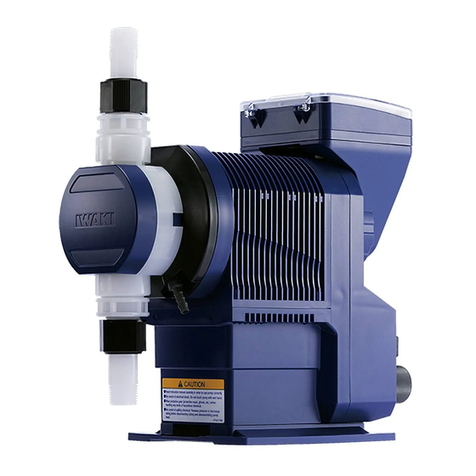
IWAKI PUMPS
IWAKI PUMPS Hi-Techno IX-B Series instruction manual
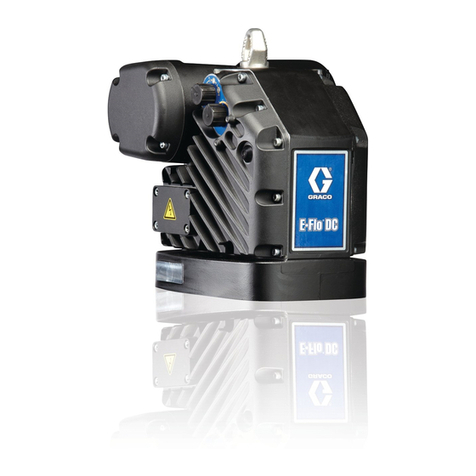
Graco
Graco E-Flo EC1140 Instructions-parts list
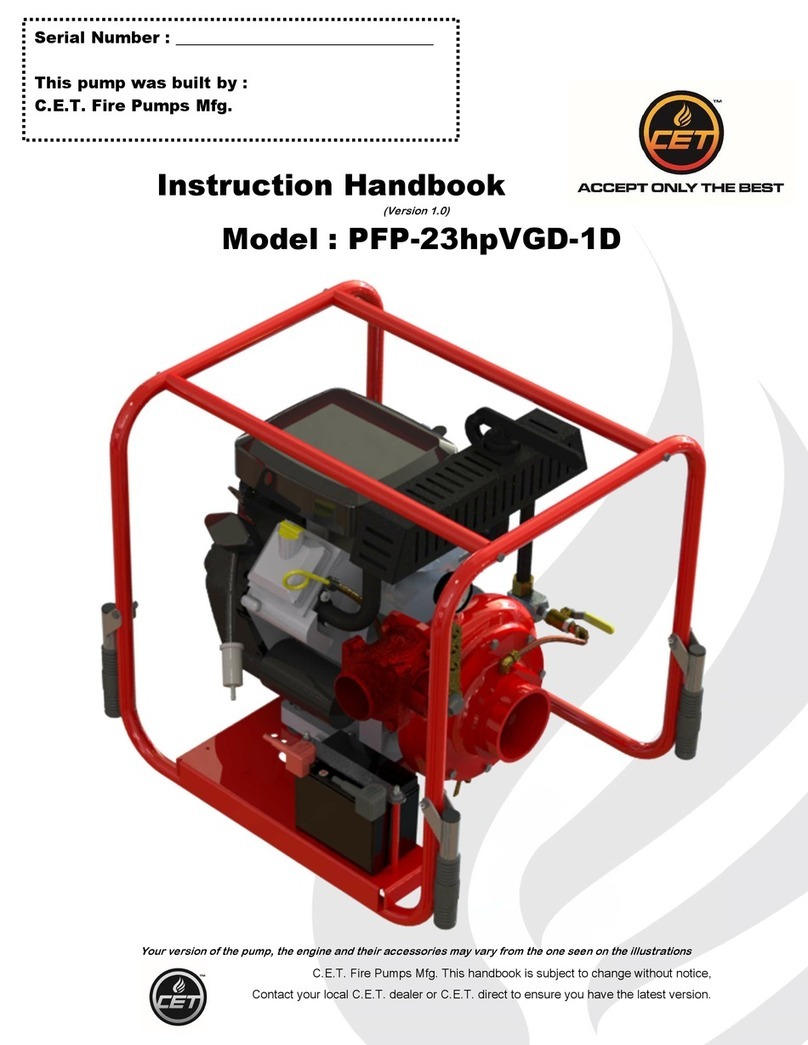
CET
CET PFP-23HPVGD-1D Instruction handbook
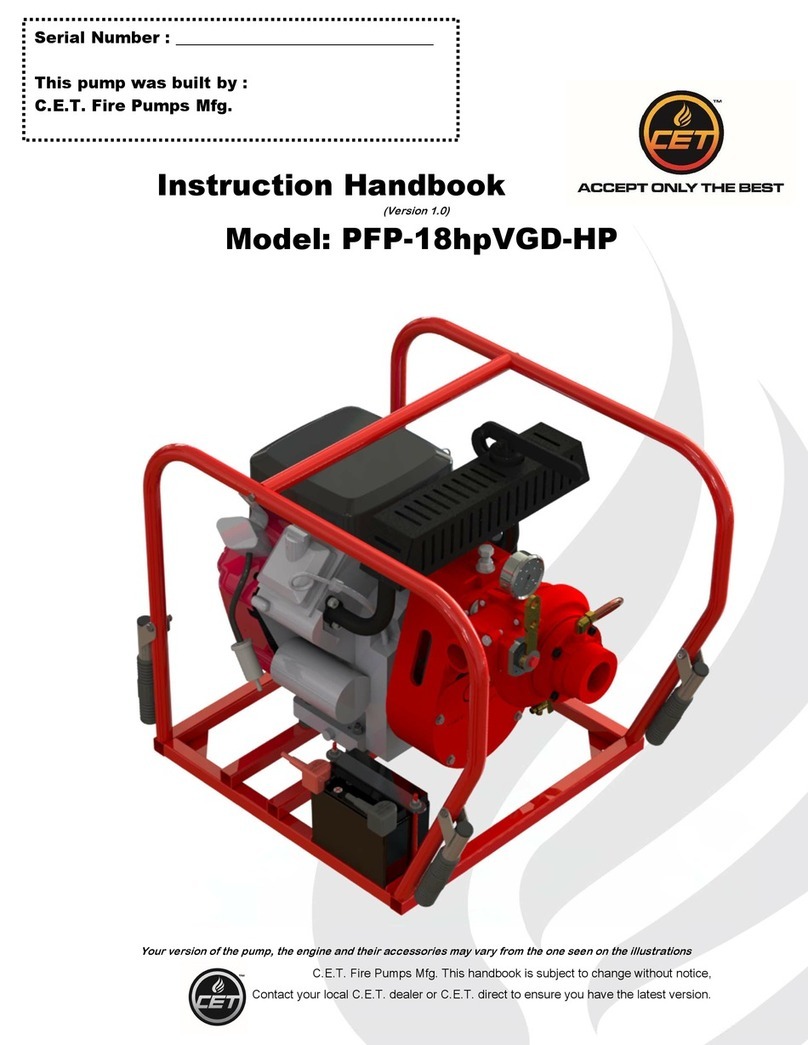
CET
CET PFP-18hpVGD-HP Instruction handbook

CET
CET PFP-13hpHND-EM-HP80 Instruction handbook
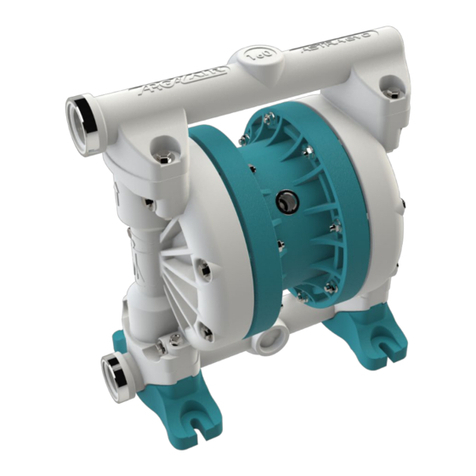
Argal
Argal ASTRA Evo DDE Series Operator and maintenance manual

Xylem
Xylem GOULDS LB instruction manual

Lafferty
Lafferty 920105 Installation & operation instructions
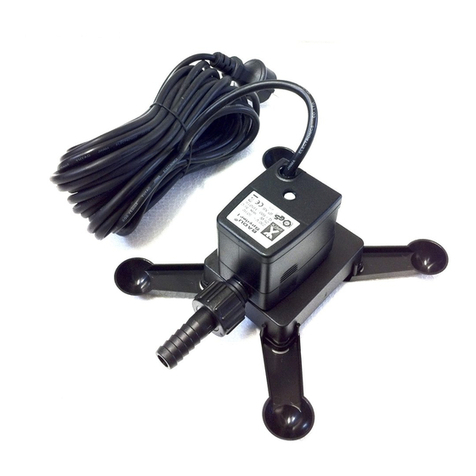
Speck pumpen
Speck pumpen BADU Spyder I operating instructions
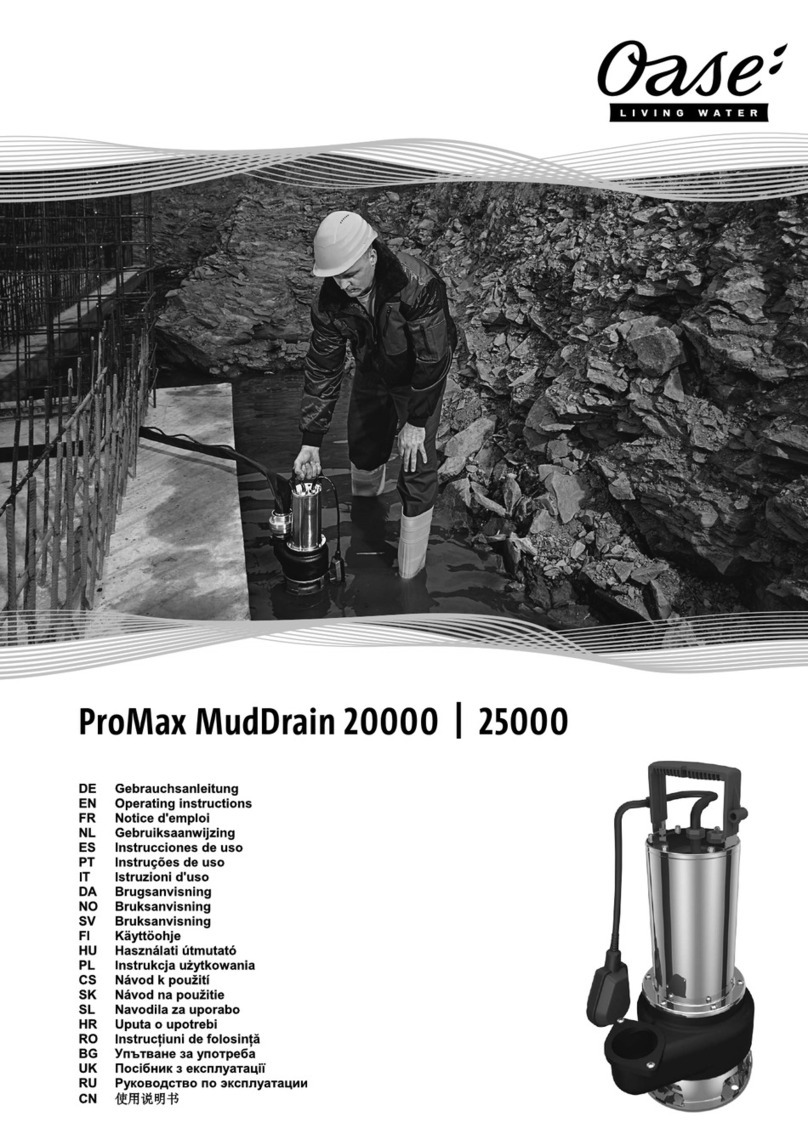
Oase
Oase ProMax MudDrain 20000 operating instructions

BUSCH
BUSCH Mink MV 0502-0602 B instruction manual
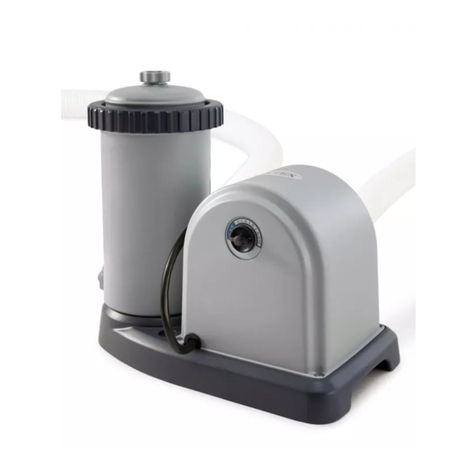
Intex
Intex Krystal Clear C1500 owner's manual
